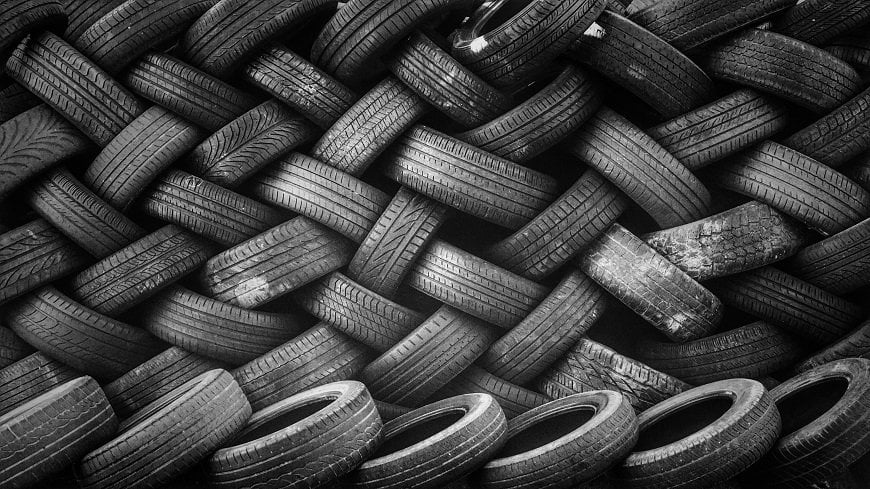
Microplastics is literally on everyone’s lips. Every person eats, drinks and breathes up to five grams of microplastics per week – and therefore basically eats a credit card. There’s not just a lot of microplastic in the air and in our drinking water. There is also another polymer that’s in everyday use: microrubber.
Drivers are familiar with this problem. Tires wear out and you have to buy a new set, for better or for worse. After all, depending on how you drive, a tire lasts about 40,000 kilometers until it has to be replaced. But where does all the rubber that originally made up the tire’s tread disappear to? It’s pretty obvious once you hit the brakes if you’re going fast. The black tracks on the asphalt are unmissable. Yet even without applying the brakes hard or taking off like a rally driver at the traffic lights, tires inevitably wear out and rubber is scattered all over the place.
Cars and trucks main source of microrubber
Researchers revolving around Bernd Nowack from the “Technology and Society” department of the Swiss Federal Laboratories for Materials Science and Technology (EMPA) in St. Gallen have calculated that between 1988 and 2018 around 200,000 tonnes of micro-rubber had accumulated in the Swiss environment alone. Among other things, they examined the import and export data on tires in Switzerland. They then linked this to a model simulating how rubber behaves on the road and in wastewater. They also analyzed the wear and tear of surfaces such as artificial turf.
The results showed that car and truck tires are the main source of microrubber. Especially given that the removal of artificial green areas such as artificial turf played only a minor role, accounting for just 3 % as Nowacj states. The remaining 97 % was the result of tire abrasion. Roughly 3 % sticks to the right and left side of the road within the first five meters. Another 5 % in the nearby residual soil and almost 20 % in water bodies. Only a small part is distributed into the air which is constantly being stirred up.

Microrubber vs microplastics
The adverse effects of microrubber on humans are evidently less severe than those of microplastics. Christoph Hüglin from Empa’s Air Pollution / Environmental Technology department estimates that the impact is only minor. According to Hüglin, a study carried out in 2009 shows that the proportion of tire abrasion in inhaled fine particles is also in the low single-digit percentage range at traffic sites.
You can find articles on microplastics here.
Nevertheless, microplastics and microrubber cannot be lumped together. “These are different particles that can hardly be compared with each other,” says Nowack. Even if microrubber does not seem to pose any danger to humans, it should not be ignored. As the amount of released microrubber exceeds that of released microplastics many times over. The scientists have calculated that only 7% of the polymer-based microparticles released into the environment are made up of plastic. Whereas the remaining 93% are made up of microrubber. “The amount of microrubber in the environment is huge and therefore highly relevant,” Nowack underlines.
Hazardous heavy metals?
While Bernd Nowack stresses that there is no health risk from microrubber, there are other well known sources that do see a danger in the tiny rubber particles. In recent years in the USA, thousands of children’s playgrounds and sports fields have been equipped with rubber surfaces made of recycled tires. Not only parents but legislators as well are concerned about the health effects on children. Car tires are not just made of rubber, but contain a lot of materials that are believed to cause cancer and other life-threatening diseases. Chemicals such as sulphur and zinc oxide are used along with various metals such as lead and cadmium, as well as harmful plasticizers and fire retardants.
A group of Indian scientists conducted a study as early as 2014 with the aim of assessing the potential risk presented by rubber particles in the air. They performed a lung function test on 60 male employees at a rubber factory and a control group. The groups were divided according to the duration they were exposed to the microrubber particles. As in, 1-3 years, 4-7 years and 8-11 years. Group 1 was a control group.
After evaluation of all lung functions of the participants, group 2, 3 and 4 showed a significant decrease in lung function compared to the control group. The worst values compared to the control group were found in the subjects in group 4. They had been exposed to the microrubber for the longest period of time. These results would indicate that lung function was affected by microrubber particles and the severity of the effect depended on the length of exposure, the researchers wrote.








